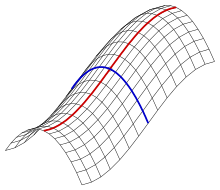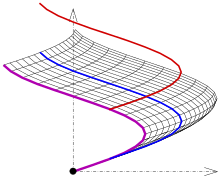Translation surface (differential geometry)

In differential geometry a translation surface is a surface that is generated by translations:
- For two space curves with a common point , the curve is shifted such that point is moving on . By this procedure curve generates a surface: the translation surface.
If both curves are contained in a common plane, the translation surface is planar (part of a plane). This case is generally ignored.



Simple examples:
- Right circular cylinder: is a circle (or another cross section) and is a line.
- The elliptic paraboloid can be generated by and (both curves are parabolas).
- The hyperbolic paraboloid can be generated by (parabola) and (downwards open parabola).
Translation surfaces are popular in descriptive geometry[1][2] and architecture,[3] because they can be modelled easily.
In differential geometry minimal surfaces are represented by translation surfaces or as midchord surfaces (s. below).[4]
The translation surfaces as defined here should not be confused with the translation surfaces in complex geometry.
Parametric representation[edit]
For two space curves and with the translation surface can be represented by:[5]
- (TS)
and contains the origin. Obviously this definition is symmetric regarding the curves and . Therefore, both curves are called generatrices (one: generatrix). Any point of the surface is contained in a shifted copy of and resp.. The tangent plane at is generated by the tangentvectors of the generatrices at this point, if these vectors are linearly independent.
If the precondition is not fulfilled, the surface defined by (TS) may not contain the origin and the curves . But in any case the surface contains shifted copies of any of the curves as parametric curves and respectively.
The two curves can be used to generate the so called corresponding midchord surface. Its parametric representation is
- (MCS)
Helicoid as translation surface and midchord surface[edit]


A helicoid is a special case of a generalized helicoid and a ruled surface. It is an example of a minimal surface and can be represented as a translation surface.
The helicoid with the parametric representation
has a turn around shift (German: Ganghöhe) . Introducing new parameters [6] such that
and a positive real number, one gets a new parametric representation
which is the parametric representation of a translation surface with the two identical (!) generatrices
- and
The common point used for the diagram is . The (identical) generatrices are helices with the turn around shift which lie on the cylinder with the equation . Any parametric curve is a shifted copy of the generatrix (in diagram: purple) and is contained in the right circular cylinder with radius , which contains the z-axis.
The new parametric representation represents only such points of the helicoid that are within the cylinder with the equation .

From the new parametric representation one recognizes, that the helicoid is a midchord surface, too:
where
- and
are two identical generatrices.
In diagram: lies on the helix and on the (identical) helix . The midpoint of the chord is .
Advantages of a translation surface[edit]
- Architecture
A surface (for example a roof) can be manufactured using a jig for curve and several identical jigs of curve . The jigs can be designed without any knowledge of mathematics. By positioning the jigs the rules of a translation surface have to be respected only.
- Descriptive geometry
Establishing a parallel projection of a translation surface one 1) has to produce projections of the two generatrices, 2) make a jig of curve and 3) draw with help of this jig copies of the curve respecting the rules of a translation surface. The contour of the surface is the envelope of the curves drawn with the jig. This procedure works for orthogonal and oblique projections, but not for central projections.
- Differential geometry
For a translation surface with parametric representation the partial derivatives of are simple derivatives of the curves. Hence the mixed derivatives are always and the coefficient of the second fundamental form is , too. This is an essential facilitation for showing that (for example) a helicoid is a minimal surface.
References[edit]
- ^ H. Brauner: Lehrbuch der Konstruktiven Geometrie, Springer-Verlag, 2013,ISBN 3709187788, 9783709187784, p. 236
- ^ Fritz Hohenberg: Konstruktive Geometrie in der Technik, Springer-Verlag, 2013, ISBN 3709181488, 9783709181485, p. 208
- ^ Hans Schober: Transparente Schalen: Form, Topologie, Tragwerk, John Wiley & Sons, 2015, ISBN 343360598X, 9783433605981, S. 74
- ^ Wilhelm Blaschke, Kurt Reidemeister: Vorlesungen über Differentialgeometrie und geometrische Grundlagen von Einsteins Relativitätstheorie II: Affine Differentialgeometrie, Springer-Verlag, 2013,ISBN 364247392X, 9783642473920, p. 94
- ^ Erwin Kruppa: Analytische und konstruktive Differentialgeometrie, Springer-Verlag, 2013, ISBN 3709178673, 9783709178676, p. 45
- ^ J.C.C. Nitsche: Vorlesungen über Minimalflächen, Springer-Verlag, 2013, ISBN 3642656196, 9783642656194, p. 59
- G. Darboux: Leçons sur la théorie générale des surfaces et ses applications géométriques du calcul infinitésimal, 1–4, Chelsea, reprint, 972, pp. Sects. 81–84, 218
- Georg Glaeser: Geometrie und ihre Anwendungen in Kunst, Natur und Technik, Springer-Verlag, 2014, ISBN 364241852X, p. 259
- W. Haack: Elementare Differentialgeometrie, Springer-Verlag, 2013, ISBN 3034869509, p. 140
- C. Leopold: Geometrische Grundlagen der Architekturdarstellung. Kohlhammer Verlag, Stuttgart 2005, ISBN 3-17-018489-X, p. 122
- D.J. Struik: Lectures on classical differential geometry, Dover, reprint ,1988, pp. 103, 109, 184

































![{\displaystyle {\begin{aligned}{\vec {X}}(\alpha ,\varphi )&=\left(a\cos \alpha ,a\sin \alpha ,{\frac {k\alpha }{2}}\right)\ +\ \left(a\cos \varphi ,a\sin \varphi ,{\frac {k\varphi }{2}}\right)\\[5pt]&={\frac {1}{2}}(\delta _{1}(\alpha )+\delta _{2}(\varphi ))\ ,\quad \end{aligned}}}](https://wikimedia.org/api/rest_v1/media/math/render/svg/a0f11bc9850270b520fe023a742d935c82b78b3a)










